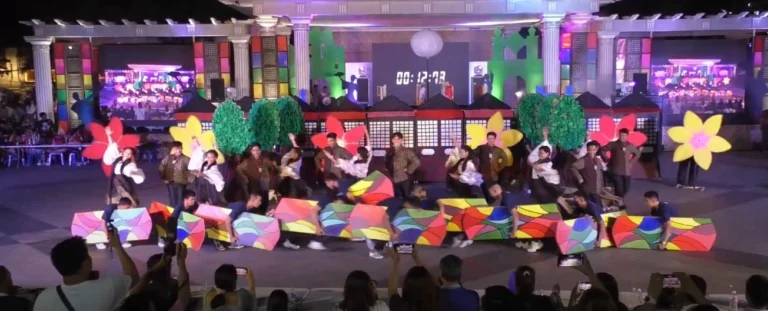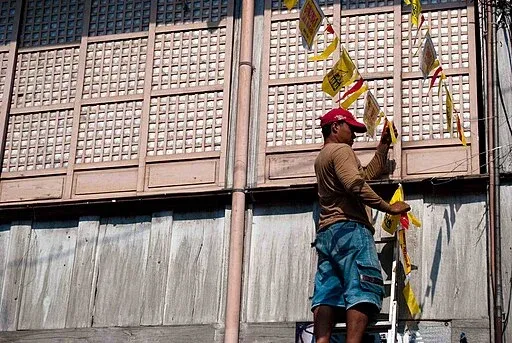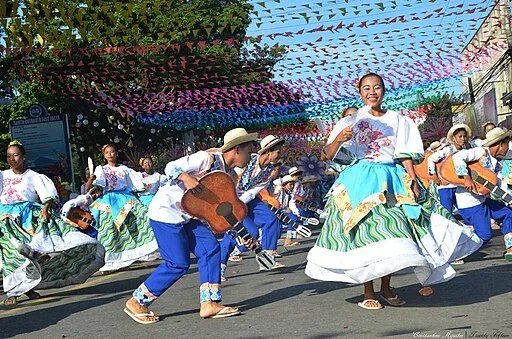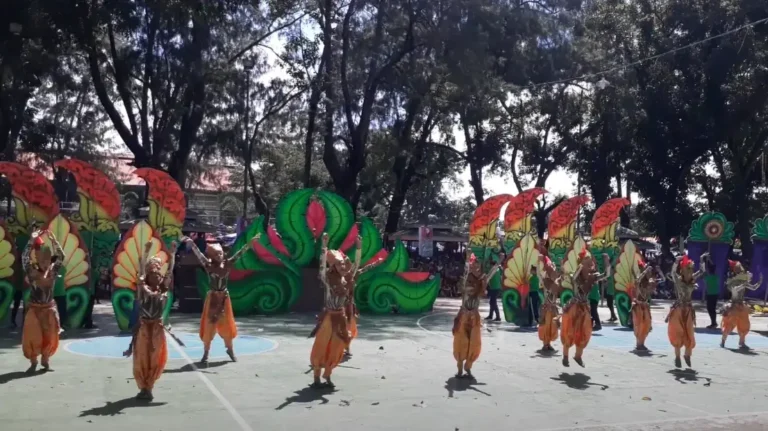Araw ng Dabaw Festival Davao City Philippines
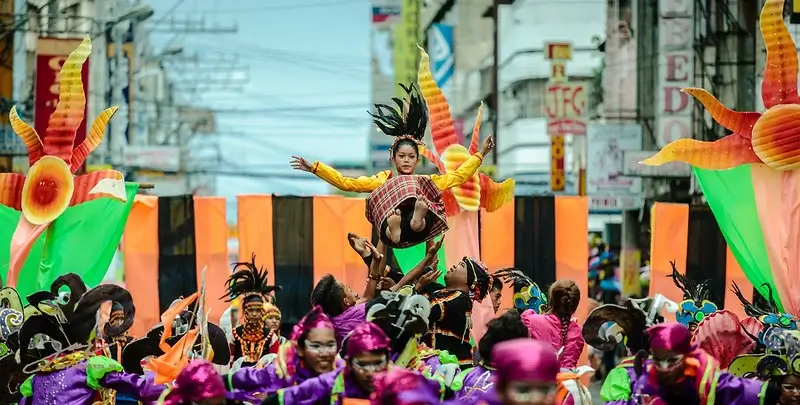
Image credit: Flickr
As you immerse yourself in the vibrant culture and rich history of Davao City, you will find yourself captivated by the Araw ng Dabaw Festival. This annual celebration marks the Foundation Day of Davao City and showcases the diverse traditions and customs of the Davaoeño people.
The festival features parades and floats that fill the streets with colour and music, while the crowning of Mutya ng Dabaw highlights the beauty and grace of local women.
Throughout the festival, you will have the opportunity to experience cultural shows and witness the street festivities that bring the community together in celebration of their heritage.
This event provides a unique insight into the Davaoeño culture and is a truly unforgettable experience.
Facts About Araw ng Dabaw Festival Philippines
| Facts | Explanation |
|---|---|
| Name of the Festival | Araw ng Dabaw Festival |
| Type of Festival | Cultural and historical celebration |
| Festival Etymology | “Araw ng Dabaw” translates to “Day of Davao,” referring to the founding anniversary of the city of Davao in the Philippines. |
| Brief History of the Festival | The Araw ng Dabaw Festival commemorates the founding of Davao City on March 16, 1936. It features various cultural, historical, and entertainment events, showcasing the city’s heritage and progress. |
| Brief History of the City | Davao City is the largest city in the Philippines by land area and is known for its diverse culture, abundant natural resources, and as a hub for commerce, trade, and industry in the southern part of the country. |
| Location of the City in the Country | Davao City is located in the southeastern part of the Philippines on the island of Mindanao. |
| How to Reach the City | Davao City can be reached by air through the Francisco Bangoy International Airport, by sea through the Sasa Wharf, and by land via major highways and bus transportation. |
| Nearby Cities or Towns | – Tagum City (55 km) – Digos City (57 km) – Mati City (164 km) |
| Google Map Link | Davao City Location |
| Ethnic Information | Davao City is home to various ethnic groups, including the Lumad, Moro, and migrant communities, contributing to its rich cultural diversity. |
| Festival Main Events and Activities | – Parades and street dancing – Cultural performances – Trade fairs and food festivals – Sports events – Fireworks display |
| Famous Tourist Attractions | – Mount Apo (highest peak in the Philippines) – People’s Park – D’ Bone Collector Museum – Eden Nature Park – Philippine Eagle Center |
| Famous Food Dishes of the City | – Durian fruit and products – Tuna dishes – Pomelo fruit – Davao chocolate products |
| Landmarks in the City | – San Pedro Cathedral – Lon Wa Temple – Museo Dabawenyo – Davao Crocodile Park – Jack’s Ridge |
| Related Festivals in the Region | – Kadayawan Festival (Davao City) – Kalivungan Festival (Soccsksargen region) – T’nalak Festival (South Cotabato) – Kaamulan Festival (Bukidnon) – Higalaay Festival (Cagayan de Oro) – Hinugyaw Festival (Koronadal) – Pakaradjan Festival (General Santos) |
Foundation Day Celebrations
Before we dive into the vibrant and lively celebrations of the Araw ng Dabaw Festival, let’s take a moment to understand the significance of Foundation Day in Davao City.
History and Origin
The Foundation Day of Araw ng Dabaw commemorates the official founding of Davao City on March 16, 1937. This date marks the signing of Act 2711 by then-President Manuel L. Quezon, which created Davao City as a charter city in the Philippines.
The city has since thrived and grown into the vibrant metropolis that it is today, and the Foundation Day celebrations serve as a reminder of the rich history and heritage of this remarkable city.
Modern Observances
In modern times, the Foundation Day of Davao City is celebrated with a range of activities and events that showcase the city’s culture and traditions.
The festivities include parades, cultural shows, street festivals, and the much-anticipated Mutya ng Dabaw beauty pageant. The city comes alive with colourful floats, lively performances, and an abundance of street food and local delicacies.
It is a time for Davaoeños to come together and celebrate the unique and diverse culture that defines their city.
Parades and Floats
Obviously, one of the most anticipated events during the Araw ng Dabaw Festival is the grand parade and floats procession.
People from all over the city gather along the parade route, decked out in their best traditional attire, ready to enjoy the stunning display of culture and creativity.
Themes and Preparation
When it comes to parades and floats, each year brings a new theme that sets the stage for the stunning displays you’ll see.
Months of preparation go into creating the elaborate floats, with organizations and groups competing to showcase the most innovative and captivating designs. You’ll be amazed by the attention to detail and the way each float brings the theme to life.
Highlights and Attractions
The parades and floats are a major highlight of the Araw ng Dabaw Festival, and for good reason. As you watch the procession, you’ll be treated to a vibrant spectacle of colours, music, and dance, with each float representing a different aspect of Davao City’s rich cultural heritage.
The energy is infectious, and you can’t help but feel a sense of pride as you witness the incredible talent and creativity on display.
Mutya ng Dabaw
After the foundation day festivities and parades, one of the most highly anticipated events of the Araw ng Dabaw festival is the Mutya ng Dabaw pageant.
This prestigious annual beauty pageant is a highlight of the celebration, showcasing the grace, beauty, and intelligence of the Davaoeñas.
Beauty Pageant Significance
The Mutya ng Dabaw beauty pageant holds great significance in the local community. It serves as a platform for young women to showcase their talents, intelligence, and leadership qualities.
The pageant also aims to promote the value of self-confidence and empowerment among the contestants. Additionally, it provides a unique opportunity for the participants to represent Davao City and its diverse culture.
Role in Promoting Culture
The Mutya ng Dabaw beauty pageant plays a crucial role in promoting the rich cultural heritage of Davao City. The contestants not only exude elegance and charm but also showcase their knowledge of local traditions and customs.
Through their performances and interviews, they often highlight the unique aspects of Davaoeño culture, including traditional dances, music, and attire. The pageant serves as a powerful platform for preserving and promoting the local cultural identity.
Cultural Shows and Performances
Despite the festive atmosphere of Araw ng Dabaw, the cultural shows and performances hold a significant place in celebrating the rich heritage and traditions of Davao City. These showcases are a vibrant display of the city’s diverse cultural influences and are not to be missed.
Traditional Music and Dance
One of the highlights of the cultural shows during Araw ng Dabaw is the traditional music and dance performances. You will be treated to the mesmerizing rhythms of indigenous music and the graceful movements of traditional dances that have been passed down through generations.
The vibrant costumes and intricate choreography will leave you in awe of the rich cultural tapestry of Davao City.
Showcasing Davaoeño Talents
Another aspect of the cultural shows is the showcasing of Davaoeño’s talents. From poetry readings to contemporary dance performances, you will witness the immense talent and creativity of the local artists.
The performances often reflect the unique identity and experiences of the Davaoeños, offering you a deeper insight into the local culture and art scene.
Street Festivities
To truly immerse yourself in the vibrant culture of Davao City during the Araw ng Dabaw Festival, you cannot miss the street festivities. The streets come alive with colourful decorations, music, and dance as locals and tourists join together to celebrate the city’s foundation day.
Each street is adorned with vibrant banners and streamers, creating a festive atmosphere that is truly infectious.
Community Involvement
As you walk through the streets of Davao City during the Araw ng Dabaw Festival, you will witness a strong sense of community involvement. Residents come together to showcase their talents through street performances, art exhibits, and cultural displays.
You will find yourself surrounded by the warm and welcoming spirit of the Davaoeño people, making you feel like a part of the community celebration.
Vendors and Street Food
One of the highlights of the street festivities during the Araw ng Dabaw Festival is the array of vendors selling traditional delicacies and local street food. You will be tempted by the enticing aroma of grilled skewers, freshly cooked seafood, and sweet treats as you stroll through the bustling streets.
However, be cautious when indulging in street food and ensure that you only eat from reputable vendors to avoid any health risks. Sampling the local street food is a delightful way to experience the diverse flavours of Davao City, but it is essential to be mindful of hygiene and food safety.
Davaoeño Culture and Heritage
Lastly, let’s delve into the vibrant culture and rich heritage of the Davaoeño people. The city of Davao is home to a diverse mix of ethnic groups, including the Bagobo, Mandaya, Mansaka, and many others.
This cultural melting pot has given rise to a unique and distinct Davaoeño culture that is celebrated and cherished by its people.
Experiencing the Local Lifestyle
When you visit Davao City, you’ll have the opportunity to immerse yourself in the local lifestyle and experience the everyday traditions of the Davaoeño people.
From savouring traditional delicacies like durian, mangosteen, and pomelo to participating in community events and celebrations, you’ll gain a deeper understanding of the customs and values that are intrinsic to the Davaoeño way of life.
You’ll be struck by the hospitality and warmth of the locals, which will make you feel right at home in this vibrant city.
Preservation of Traditions
Despite the rapid modernization of Davao City, the Davaoeño people are unwavering in their commitment to preserving their age-old traditions and customs.
You’ll witness this dedication in the colourful festivals, dances, and rituals that are an integral part of Davaoeño culture.
The passion and pride with which these traditions are upheld are truly inspiring, and you’ll find yourself captivated by the deep-rooted sense of cultural identity that permeates every aspect of life in Davao.
Interesting Facts About The Araw ng Dabaw Festival Philippines
- 📅 The Araw ng Dabaw Festival is celebrated every March 16th, commemorating the creation of Davao City by a Presidential Decreeback in 1936.
- 🌺 The festival features a unique beauty pageant, “Mutya ng Dabaw,” which is not just about beauty but also emphasizes intelligence, cultural understanding, and community involvement.
- 🍴 “Kaon Dabaw” is a gastronomic event during the festival where visitors can indulge in local cuisines and delicacies, showcasing Davao’s rich culinary heritage.
- 🎭 The “Sayaw Mindanaw” is a dance competition highlighting the diverse cultures and traditional dances of Mindanao, promoting unity and cultural understanding.
- 🌳 A significant part of the festival is dedicated to environmental conservation efforts, including tree planting activities, to emphasize the city’s commitment to preserving its natural resources.
- 🏃♂️ “Dagan Dabaw” is a fun run event that promotes health and wellness among participants, with various categories accommodating all ages and fitness levels.
- 🎈 The “Pahalipay sa Dabaw” features a series of concerts and fireworks displays, bringing joy and entertainment to both locals and visitors.
- 🎨 Street art competitions and exhibits are held during the festival, showcasing local talents and highlighting the city’s vibrant arts scene.
- 🌏 Araw ng Dabaw is a melting pot of cultures, with various indigenous groups and communities participating in the festivities, reflecting the city’s multicultural identity.
- 🕊️ The festival promotes peace and unity, with events designed to foster harmony among Davao’s diverse population, including interfaith prayers and dialogues.
Summary of Araw ng Dabaw Festival Philippines
| Fact | Detail | Reference or Contact |
|---|---|---|
| Name of Event | Araw ng Dabaw | City Government of Davao |
| Date of Event | March 1 | |
| Duration | 1 month | |
| Location | Davao City, Davao del Sur, Philippines | |
| Established | 1936 (Cityhood) | |
| Historical Event | Cityhood of Davao City | History – City Government of Davao |
| Organizer | City Government of Davao | Contact: (082) 222 1956 or Email: [email protected] |
| Activities | MICECON, agri-trade fair, sporting events, art and music festival, anniversary program, talent contests, beauty pageant (Reyna Dabawenya and Mutya ng Dabaw), Davao Unity Awards, etc. | Araw ng Dabaw – City Government of Davao |
| Holiday Legislation | Republic Act No. 7551, Republic Act No. 7685, Republic Act No. 11379 | Republic Act No. 7551 – Senate of the Philippines, Republic Act No. 7685 – Official Gazette, Republic Act No. 11379 – Official Gazette |
| Historical Background References | National Economic and Development Authority Region XI – Davao Region, Britannica, Museo Dabawenyo | NEDA Region XI, Davao City – Britannica, Davao City History – Museo Dabawenyo |
| Additional Historical Events | Inauguration of Davao City on March 1, 1937; Division of Davao into separate provinces in 1967; Designation as the regional center of Region XI | Proclamation No. 132, s. 1937 – Official Gazette, REPUBLIC ACT NO. 4867 – Supreme Court of the Philippines |
What Is the Significance of the Araw ng Dabaw Festival compared to the Bangus Festival?
The Araw ng Dabaw Festival holds significant cultural and historical importance for the people of Davao City, marking the founding anniversary of the city. On the other hand, the Bangus festival in Pangasinan celebrates the thriving Bangus industry and the province’s rich aquatic resources. Both festivals showcase the unique traditions and heritage of their respective regions.
Conclusion
Following this celebration, you now have a deeper understanding of the Araw ng Dabaw Festival in Davao City, Philippines.
The festival not only celebrates the foundation day of the city, but also showcases the vibrant Davaoeño culture through parades, floats, cultural shows, and street festivities. The highlight of the festival, the Mutya ng Dabaw pageant, crowns a young lady who embodies the beauty, intelligence, and values of the citizens of Davao.
The Araw ng Dabaw Festival truly exemplifies the rich and diverse cultural heritage of Davao City, making it a must-see event for anyone looking to experience the traditions and celebrations of the Philippines.
Frequently Asked Question
What is Araw ng Dabaw?
Araw ng Dabaw, celebrated every March 1, marks the cityhood anniversary of Davao City. It is a special non-working holiday observed under Republic Act No. 11379. The festival features a month-long series of events including concerts, trade fairs, pageants, and more.
How was Davao City founded?
Davao City’s history began as a region inhabited by indigenous and Muslim populations. It came under Spanish control in 1848. Davao City was officially created through Commonwealth Act No. 51, approved on October 16, 1936, by President Manuel L. Quezon. The city was inaugurated on March 1, 1937.
What are some highlights of the Araw ng Dabaw celebration?
The celebration includes a variety of events such as the Araw ng Dabaw Artisan Food and Cacao Market, Hugyaw Dabaw – All-Star Variety Show, Music and Art Street Festival with 3D Drone Show, and the Mutya ng Dabaw beauty pageant. Other events include academic competitions, cultural presentations, and the vibrant Parada Dabawenyo
What makes Araw ng Dabaw unique?
Araw ng Dabaw is a vibrant celebration of the unity and cultural diversity of Davaoeños. It includes a grand parade, arts, cultural, musical, culinary, sports, and street events. It showcases the city’s rich cultural heritage and fosters a sense of community among residents and visitors alike.

